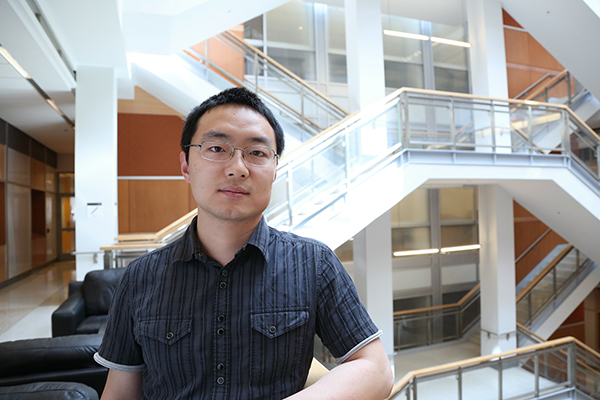Aziz Sancar, MD,
PhD (Photo by Max Englund, UNC School of Medicine)
The new experimental assay can help scientists find the
precise locations of repair of DNA damage caused by UV radiation and common
chemotherapies. The invention could lead to better cancer drugs or improvements
in the potency of existing ones.
(May 1, 2015) When the common chemotherapy drugs cisplatin
or oxaliplatin hit cancer cells, they damage DNA so that the cells can’t
replicate. But the cells have ways to repair the DNA. The cancer drugs aren’t
as effective as patients need. Researchers at the UNC School of Medicine and
UNC Lineberger Comprehensive Cancer Center have developed a method for finding
where this DNA repair happens throughout all of human DNA.
Jinchuan Hu, PhD,
worked with Aziz Sancar to create DNA repair map of
the entire human
genome (Photo by Max Englund)
The findings, published in the journal Genes &
Development, offers scientists a potential way to find and target the proteins
cancer cells use to circumnavigate therapy. The benefit of this new method
could be more effective and better tolerated classes of cancer therapeutics.
The research, led by Aziz Sancar, MD, PhD, the Sarah Graham
Kenan Professor of Biochemistry and Biophysics, marks the first time scientists
have been able to map the repair of DNA damage over the entire human genome.
“Now we can say to a fellow scientist, ‘tell us the gene
you’re interested in or any spot on the genome, and we’ll tell you how it is
repaired,’” said Sancar, co-senior author and member of the UNC Lineberger
Comprehensive Cancer Center. “Out of six billion base pairs, pick out a spot
and we’ll tell you how it is repaired.”
Sheera Adar, PhD,
worked with Aziz Sancar to create DNA repair
map of the entire
human genome (Photo by Max Englund)
When DNA is damaged, cells use many enzymes to cut the
strand of DNA and excise the damaged fragment. Then, other enzymes repair the
original DNA so that the cells can function properly. Previously, Sancar’s lab
used purified enzymes to discover how this process happens in DNA damaged by UV
irradiation and by chemotherapeutic drugs such as cisplatin and oxaliplatin.
In recent years, Michael Kemp, PhD, a researcher on Sancar’s
team found that a particular protein called TFIIH bound tightly to the excised
damaged DNA fragment in the test tube. But for this information to be truly
useful to biomedical researchers, the experiment needed to be replicated in
human cells. Extracting a stable TFIIH-DNA fragment proved difficult. Not until
postdoctoral fellow Jinchuan Hu, PhD, co-first author on the Genes &
Development paper, joined Sancar’s lab could Sancar’s team accomplish the task.
Through a series of sophisticated experiments with human
skin cells, Hu exposed the cells to ultraviolet radiation and used an antibody
against the enzyme TFIIH to isolate the enzyme complex with the excised DNA
damage. Then he created experimental techniques to pull the enzyme – as well as
the excised DNA fragment it was bound to – from the cells.
The fragment was stable enough for Sancar’s lab to sequence
it. Then, Sheera Adar, PhD, fellow postdoc and paper co-first author, and Jason
Lieb, PhD, co-senior investigator of the study, used their expertise in
computational biology to analyze where the DNA repair happened throughout the
entire genome and thus generate a human genome repair map for the first time.



